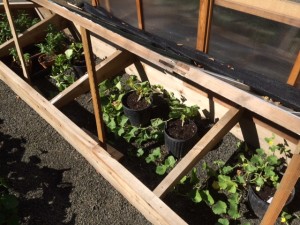GROWING VEGETABLES IN CONTAINERS
Raising vegetables in containers is an excellent option for those of us who are living in a dwelling temporarily, are short of space, or have poor soil. Containers are useful and versatile; pots can be moved around if a location is too hot, windy or shady. Plants that enjoy heat, such as melons, squash, peppers, tomatoes and eggplant can be placed in front of a warm south or west wall to ripen faster. Also, if spring cold weather threatens, pots may be moved inside overnight, or even a few days for protection. The same advantage applies to the fall season; if weather turns cold and your crop is not yet ripe you can bring pots inside.
Containers for vegetables should be at least 12 inches by 12 inches for a single tomato or eggplant, but much larger containers are needed for cantaloupe, melons, squash and pumpkins—at least 24 inches by 24 inches for each plant. My photo above shows heirloom French cantaloupe in containers inside a cold frame. I moved the plants up to larger containers soon after this photo was taken. Smaller crops, such as carrots, beets, broccoli, cabbage, Swiss chard, spinach, lettuce, etc. need a container at least 10 inches deep, and yields are better if the pots are 24 to 36 inches wide. For peas and beans, some gardeners have good success with containers shaped like long rectangles, perhaps 12 inches wide by 48 inches long and 10 or more inches deep. It is easier to move your containers around if you have them on rollers. And if you build your own containers, use non-treated water-resistant wood such as cedar, redwood or cypress. It helps to drill holes in the pots for drainage, too. Containers for vegetables can be made of wood, paper, wood pulp, plastic, rubber tires, or even an old bathtub will work. The important thing to remember is to give the plants drainage (holes in the bottom of the container, and not too heavy a soil mix). The new fabric containers are useful, reusable and inexpensive, but their disadvantage is that they cannot be moved around during the season without damage to the crop.
The soil mix for vegetables should be rich, moisture-retentive, but quick draining. Plant roots need air to thrive. I use a mix of two parts organic potting soil, one part rotted manure or compost, and one part perlite or sharp sand. I also add rock phosphate or bone meal for phosphorous, and wood ashes or kelp meal for potash. Greensand is a great source for trace minerals. Consistent, frequent applications of manure tea, liquid seaweed or a complete organic fertilizer will keep your vegetables growing well.
Watering is very important when growing in containers. Check plants every day all season long. If weather is hot and the plants are large, you might have to water two or three times a day. Automatic drip watering systems are an option if you will be away for a few days.
When planting seeds, follow directions on the package and read about how to care for each vegetable. “Patio”, “bush” or dwarf varieties of vegetables are good choices for containers. They tend to be compact, productive plants with normal size or slightly smaller fruit. Vegetable seeds that can be planted now (July) include: lettuce, spinach, peas, radishes, carrots, corn salad, and Swiss chard. Plant starts of cabbage, cauliflower, broccoli and kale can be planted now for late fall harvest. Starts of tender vegetables that can be planted in containers now include: tomatoes, squash, pumpkins, cantaloupe, watermelon, eggplant and peppers.

